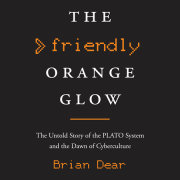PREFACEImagine discovering that a small group of people had invented a fully functioning jet airplane capable of flying long distances at hundreds of miles per hour,
decades before the Wright brothers cast their fragile craft into the wind for twelve seconds over North Carolina sand dunes in 1903. Imagine how such a discovery would disrupt our common understanding of history. The story of PLATO, a computer system so far ahead of its time and perhaps the least known major twentieth-century technology project, may strike you as just as impossible as a nineteenth-century jet, but PLATO really happened. It is a story of inventors, mavericks, hackers, geniuses, visionaries, scientists, and educators who came together not so long ago in the very heart of the American Midwest, a story that so disrupts the conventional view of twentieth-century technology history that it may make you wonder, as it has made this author wonder,
How could this have happened? Where are the books, the magazine articles, the documentaries, and the museum displays that should have covered this story? Why has this story gone untold? Why are we only finding out about this now?
Having begun using PLATO in 1979, as an undergraduate at the University of Delaware, I developed an insatiable curiosity about who these people were. I wanted to understand where they came from. I kept asking myself, Why is the world ignoring this incredible phenomenon? After a number of years, I decided I was not going to wait any longer for someone to come along and write the history documented in this book, so I reluctantly set out to do it myself.
And here we are. What follows in these pages is an attempt to provide a glimpse into the largely unknown world of PLATO. As you read the following chapters, pay attention to dates. Considering what innovations are being described—many of them things we now use every day of our lives—it is hard to believe how many years ago these things came about, long before personal computing, social media, and the Internet existed. A book about the history of the PLATO system turns out not to be just about PLATO. It also sheds new light on the origins of diverse fields, from what we now call e-learning or personalized instruction, to flat-panel displays and touch-sensitive screens; from time-sharing to cloud computing; from MUDs and other multiplayer games to online communities and social networking. To absorb the history of PLATO leads to a better understanding and deeper appreciation of all these areas of innovation, and of the nature of innovation itself.
***
In the American study of economics there are two prevailing schools of thought, one called the “saltwater” view and the other called the “freshwater” view. The economic details of each view are unimportant here. What’s notable is that the saltwater view refers to the predominant economics mindset at universities and think tanks on the East and West Coasts of the United States. The freshwater view belongs primarily to Midwestern economists closer to Lake Superior and Lake Michigan, mainly at the University of Chicago.
Unlike in economics, in the popular history of computing there’s one prevailing view, and it’s a saltwater view: of, by, and for the two coasts, with its centers being Silicon Valley and Cambridge, Massachusetts. Whether the view was taught in school, broadcast on television, depicted in movies, printed in books or magazines, or published on the Internet, the view holds that most of the great American computer innovations of the twentieth century share one thing in common.: they happened on the coasts. The history of the last sixty years of computing, from mainframes to the rise of the Internet, from silicon chips to the revolution brought forth by the personal computer, to, in more recent years, the marvels of smartphones, portable digital music players, touch-based tablet computers, search engines, billion- user social networks, online stores—these are breakthroughs that came about on the coasts.
So used to saltwater stories of the Next Big Thing in technology are we that we have largely missed what went on between the coasts. To this day, many of these freshwater accomplishments have gone unnoticed.
We celebrate the rise of ARPANET, the Internet, and the World Wide Web. We celebrate the accomplishments of Xerox’s Palo Alto Research Center, which in turn inspired Apple’s Lisa and Macintosh computers and much of the personal computing environments we still use today. We celebrate the innovations produced by legions of start-up companies and placed into the hands of millions, now billions of people: Innovations that have changed the world. Innovations people cannot
imagine living without. We are living in the very “shocking future” Alvin Toffler wrote about—warned us about—forty-five years ago. And the history of how we reached this future has been researched, deciphered, studied, analyzed, organized, and disseminated far and wide for long enough that the story has become legend, set in stone. Nerds, geeks, and hackers are no longer outcasts and ridiculed; they’re now sought-after “thought leaders,” many counted among the tens of thousands of recent millionaires and hundreds of billionaires. The list of heroes’ names in the “computer revolution” is long. But there is an equally long list of unknown computer pioneers, the people whose stories fill the pages of this book.
***
To be in the great state of Illinois is to be hours away by jet, days by car or rail, from the West or East Coasts, each a thousand miles away. To be in Illinois is, instead, to be in the heart of the fruited plain, that vast prairie with soil so rich you could jam a broomstick into it and leaves would sprout. Some 80 percent of the state’s nearly 58,000 square and famously flat miles are devoted to farming, much of it corn and, in more recent years, soy. Endless farmland surrounds most Illinois cities and towns, which pop up like islands in a sea of green.
Out in the middle of that fruited Illinois plain there’s a place where a lot of the future we take for granted today got started, long ago. The town is Urbana, and the place is one of the largest universities in the United States: the University of Illinois at Urbana-Champaign. On UI’s campus there’s one particular building that is at the very heart of our story. Most of the events chronicled in the pages that follow took place in this particular building, or if they took place elsewhere (sometimes clear across the world), they did so
only because of prior things that had taken place in this building. What went on in this building changed lives. It may have changed yours and you don’t even realize it. What happened in this building changed the world. And unlike every other major technology story of the twentieth century, very few have heard of it: the PLATO system was born in this building.
The building’s PLATO presence is long gone, the names and numbers on office doors scraped off long ago. The mechanical engineering department took over the building years ago, filling remodeled offices with researchers working on everything from improving air conditioners to “nanoscale chemical- electrical- mechanical manufacturing systems.”
The brick-walled building, four narrow stories, stands alongside Mathews Avenue, a quiet tree-lined street running north and south through the campus. The building went up during a noisier, sootier era, when railroad tracks ran through the streets, upon which rolled trolley cars, horse-drawn delivery trucks, Model Ts, and steam locomotives. Outnumbering the trees, stark utility poles supported count-less power and phone lines in every direction. One track along the north side of the building crossed the street and led into a long- gone locomotive testing plant, complete with roundhouse, where engineering students worked on real trains and engine designs.
For more than half of the building’s hundred- plus years a tower of one sort or another loomed alongside it. In 1910, as part of the original construction as the campus power plant, there stood a 175- foot- tall brick smokestack along the south side, toward the rear of the building. The stack could be seen from miles away belching out thick, black billows of smoke from the coal furnace, boilers, and steam generators inside. But in time, the campus outgrew the power plant’s capacity, so a bigger plant was built farther outside town. The smokestack was torn down, the building’s length more than doubled, and soon another tower, for radar research, was constructed on its north side.
Doric columns on either side of the entranceway’s double doors support a simple stone entablature above, engraved into which are the words “POWER HOUSE.” It’s now the only hint of the building’s distant power plant past. If it wasn’t for a small historical marker right outside the doors, there would be no hint at all that this was also the birthplace of PLATO.
The doors open to a small landing and a few steps leading up to another set of double doors. The steps, and the walls halfway up to the handrails on either side, are covered in little stone tile squares varying in shades of faded orange and earth-clay brown. Up the stairs, through the doors, down the hall, there are offices and labs. In those rooms not so long ago, atop tables and desks rested computer terminals sporting impossibly futuristic, high-resolution, touch-sensitive, flat panel gas plasma displays from which emanated a light that was at the time commonly called the Friendly Orange Glow.
***
The level to which PLATO, its people, and its history have been ignored is extraordinary given not only how seminal the innovations were and how early its online community flourished, but also how recently it all happened. PLATO was a computer system, but more important, it was a culture, both physical and online, a community that formed on its own, with its own jargon, customs, and idioms; its own cast of thousands, a world familiar to us yet subtly foreign, an entire era that clashes with the accepted, canonical history of computing, social media, online communities, online games, and online education. It’s as if an advanced civilization had once thrived on earth, dwelled among us, built a wondrous technology, but then disappeared as quietly as they had arrived, leaving behind scraps of legend and artifacts that only few noticed. This book is the result of an effort to capture the history of this lost culture of innovation before it vanishes completely, by someone who had the great fortune to come of age, to “become digital,” as it were, within that very culture, thereby having a chance to get to know some of the people there, their stories, their visions, and their amazing technologies— technologies we all now recognize and use.
This book is as much the
biography of a vision as it is the story of the people behind PLATO. Every technology story, whether it’s about the steam engine, textile loom, light bulb, telephone, airplane, Model T, or, more recently, Macintosh, Google search engine, or Tesla electric car, has at its core a vision. It is the unalterable fate of technology visions that they run full life cycles from conception to obsolescence. Tech visions typically start with one person with an idea. Early on that visionary faces skepticism and rejection. But if the visionary has sufficient technical proficiency and the support of colleagues, he or she may hang on long enough to get a prototype working, an accomplishment that attracts others, who soon come to share in the vision, and thus a technology project snowballs, attracting more bright people, more funding, and, hopefully, widespread adoption. In time the vision gets stale, and the visionary grows stubborn, as others dream up new visions that challenge then replace the old. It’s how we got Facebook, the answer to MySpace, which was the answer to Friendster. It’s how we got Google, which was the answer to AltaVista, Lycos, and Info-seek. It’s how we got the iPhone after the Palm Treo, Apple Newton, and flip phones.
PLATO’s story is no different.
But what a story.
Copyright © 2017 by Brian Dear. All rights reserved. No part of this excerpt may be reproduced or reprinted without permission in writing from the publisher.










